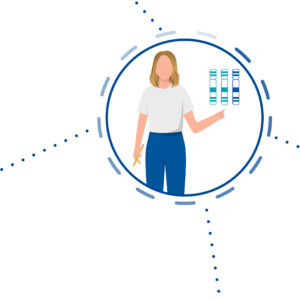Scientific Background
Muscular dystrophies cause progressive muscle weakness and degeneration. The underlying defects involve genes required for normal muscle function and the clinical manifestations are partially overlapping. Immunohistochemical or immunofluorescence staining can be used for the differentiation of some subtypes, such as dysferlinopathy, dystrophinopathy or sarcoglycanopathies. Many other defective proteins involved in the disease are not readily identifiable. The most frequently occurring muscular dystrophies are Duchenne muscular dystrophy, myotonic dystrophies, and fazioscapulohumeral muscular dystrophy. Less frequently occuring muscular dystrophies are limb-girdle, Emery-Dreifuss and the congenital muscular dystrophies. Pathogenic variants in many genes lead to this group of diseases and their differentiation often poses a great challenge.
Congenital muscular dystrophies (CMD) are rare, clinically and genetically heterogeneous with different, sometimes severe accompanying symptoms, such as malformations of the central nervous system or the eyes. The disease course is highly variable. Their prevalence is still largely unknown, although the frequency of certain subtypes varies within different population groups. Various classification strategies have been proposed, such as the classification of types into the following main categories:
- Collagenopathies: autosomal recessive and autosomal dominant (also known as collagen VI associated myopathy), including Ullrich congenital muscular dystrophy and Bethlem myopathy
- Merosinopathies: autosomal recessive (also known as merosine-deficient congenital muscular dystrophy)
- Dystroglycanopathies: autosomal recessive (alpha-dystroglycan-associated muscular dystrophies) including Fukuyama congenital muscular dystrophy, muscle eye brain disease, Walker-Warburg syndrome, primary alpha-dystroglycanopathy and muscular dystrophy-dystroglycanopathy types 10, 11 and 14
- Unclassified congenital muscular dystrophies: rigid-spine syndrome (SEPN1 and FHL1), multiminicore disease, limb-girdle muscular dystrophy (LMNA)
Muscular dystrophy, collagen-associated and others
Genes: CHKB, COL6A1, COL6A2, COL6A3, FHL1, ITGA7, SELENON
Muscular dystrophies, congenital
Genes: CHKB, COL6A1, COL6A2, COL6A3, CRPPA, DNM2, FHL1, FKRP, FKTN, ITGA7, LAMA2, LARGE1, LMNA, POMGNT1, POMGNT2, POMT1, POMT2, SELENON, TCAP
Muscular dystrophy, dystroglycanopathy type A (with brain and eye anomalies)
Genes: B3GALNT2, B4GAT1, CRPPA, DAG1, FKRP, FKTN, GMPPB, LARGE1, POMGNT1, POMGNT2, POMK, POMT1, POMT2, RXYLT1
Muscular dystrophy, dystroglycanopathy type A & B
Genes: B3GALNT2, B4GAT1, CRPPA, DAG1, FKRP, FKTN, GMPPB, LARGE1, POMGNT1, POMGNT2, POMK, POMT1, POMT2, RXYLT1
Muscular dystrophy, dystroglycanopathy type B (congenital, with mental retardation) & C
Genes: CRPPA, DAG1, FKRP, FKTN, GMPPB, LARGE1, POMGNT1, POMK, POMT1, POMT2
References
Falsaperla et al. 2016, Ital J of Ped 42:78 / Kang et al. 2015, Neurol 84:1369 / Dai et al. 2015, Neuromusc Dis 25:617 / Chae et al. 2015, J Med Genet 52:208 / Sparks et al. 2012, Genereviews





















